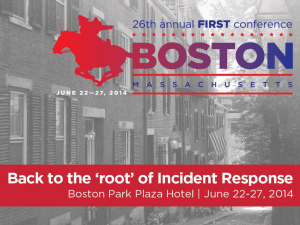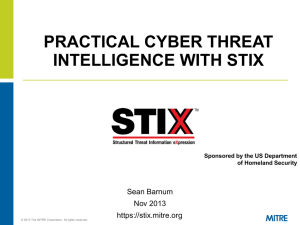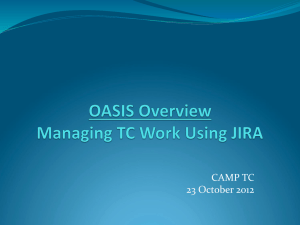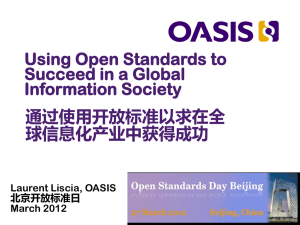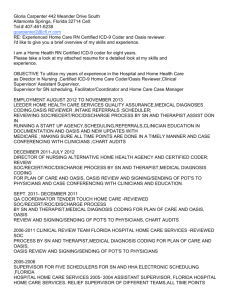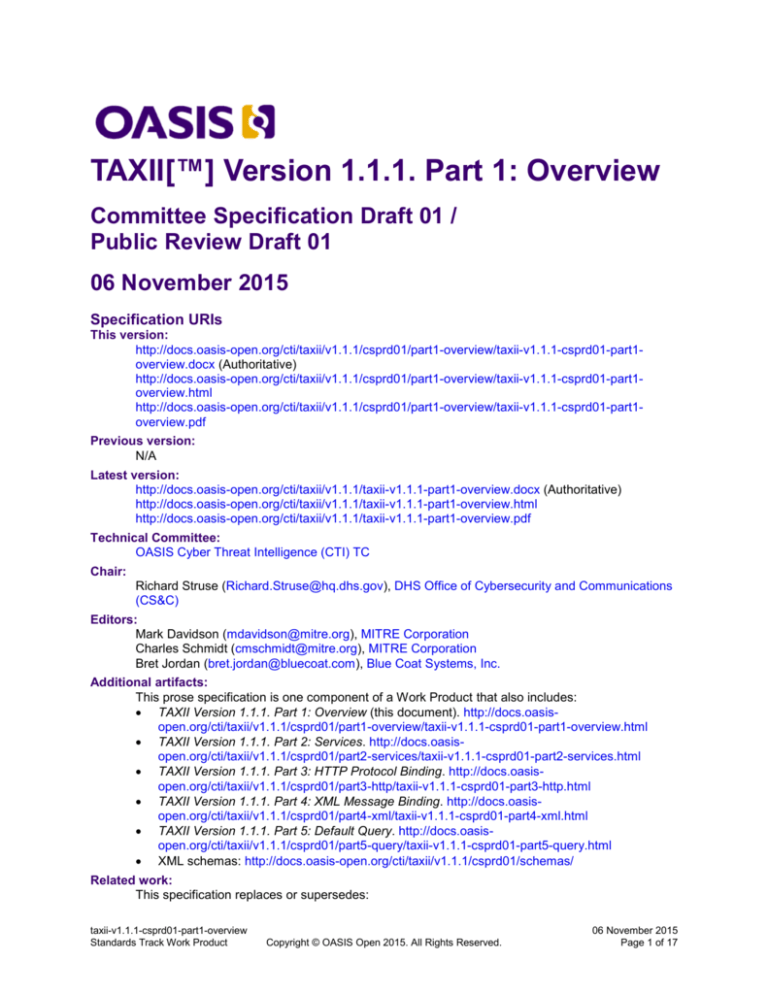
TAXII[™] Version 1.1.1. Part 1: Overview
Committee Specification Draft 01 /
Public Review Draft 01
06 November 2015
Specification URIs
This version:
http://docs.oasis-open.org/cti/taxii/v1.1.1/csprd01/part1-overview/taxii-v1.1.1-csprd01-part1overview.docx (Authoritative)
http://docs.oasis-open.org/cti/taxii/v1.1.1/csprd01/part1-overview/taxii-v1.1.1-csprd01-part1overview.html
http://docs.oasis-open.org/cti/taxii/v1.1.1/csprd01/part1-overview/taxii-v1.1.1-csprd01-part1overview.pdf
Previous version:
N/A
Latest version:
http://docs.oasis-open.org/cti/taxii/v1.1.1/taxii-v1.1.1-part1-overview.docx (Authoritative)
http://docs.oasis-open.org/cti/taxii/v1.1.1/taxii-v1.1.1-part1-overview.html
http://docs.oasis-open.org/cti/taxii/v1.1.1/taxii-v1.1.1-part1-overview.pdf
Technical Committee:
OASIS Cyber Threat Intelligence (CTI) TC
Chair:
Richard Struse (Richard.Struse@hq.dhs.gov), DHS Office of Cybersecurity and Communications
(CS&C)
Editors:
Mark Davidson (mdavidson@mitre.org), MITRE Corporation
Charles Schmidt (cmschmidt@mitre.org), MITRE Corporation
Bret Jordan (bret.jordan@bluecoat.com), Blue Coat Systems, Inc.
Additional artifacts:
This prose specification is one component of a Work Product that also includes:
TAXII Version 1.1.1. Part 1: Overview (this document). http://docs.oasisopen.org/cti/taxii/v1.1.1/csprd01/part1-overview/taxii-v1.1.1-csprd01-part1-overview.html
TAXII Version 1.1.1. Part 2: Services. http://docs.oasisopen.org/cti/taxii/v1.1.1/csprd01/part2-services/taxii-v1.1.1-csprd01-part2-services.html
TAXII Version 1.1.1. Part 3: HTTP Protocol Binding. http://docs.oasisopen.org/cti/taxii/v1.1.1/csprd01/part3-http/taxii-v1.1.1-csprd01-part3-http.html
TAXII Version 1.1.1. Part 4: XML Message Binding. http://docs.oasisopen.org/cti/taxii/v1.1.1/csprd01/part4-xml/taxii-v1.1.1-csprd01-part4-xml.html
TAXII Version 1.1.1. Part 5: Default Query. http://docs.oasisopen.org/cti/taxii/v1.1.1/csprd01/part5-query/taxii-v1.1.1-csprd01-part5-query.html
XML schemas: http://docs.oasis-open.org/cti/taxii/v1.1.1/csprd01/schemas/
Related work:
This specification replaces or supersedes:
taxii-v1.1.1-csprd01-part1-overview
Standards Track Work Product
Copyright © OASIS Open 2015. All Rights Reserved.
06 November 2015
Page 1 of 17
TAXII Overview Version 1.1. http://taxiiproject.github.io/releases/1.1/TAXII_Overview.pdf.
This specification is related to:
TAXII Content Binding Reference.
http://taxiiproject.github.io/releases/1.1/TAXII_ContentBinding_Reference_v3.pdf
Declared XML namespaces:
http://docs.oasis-open.org/cti/ns/taxii/xml/binding-1.1.1
http://docs.oasis-open.org/cti/ns/taxii/default-query-1.1.1
Abstract:
This document provides an overview of TAXII.
Status:
This document was last revised or approved by the OASIS Cyber Threat Intelligence (CTI) TC on
the above date. The level of approval is also listed above. Check the “Latest version” location
noted above for possible later revisions of this document. Any other numbered Versions and
other technical work produced by the Technical Committee (TC) are listed at https://www.oasisopen.org/committees/tc_home.php?wg_abbrev=cti#technical.
TC members should send comments on this specification to the TC’s email list. Others should
send comments to the TC’s public comment list, after subscribing to it by following the
instructions at the “Send A Comment” button on the TC’s web page at https://www.oasisopen.org/committees/cti/.
For information on whether any patents have been disclosed that may be essential to
implementing this specification, and any offers of patent licensing terms, please refer to the
Intellectual Property Rights section of the TC’s web page (https://www.oasisopen.org/committees/cti/ipr.php).
Citation format:
When referencing this specification the following citation format should be used:
[TAXII-v1.1.1-Overview]
TAXII[™] Version 1.1.1. Part 1: Overview. Edited by Mark Davidson, Charles Schmidt, and Bret
Jordan. 06 November 2015. OASIS Committee Specification Draft 01 / Public Review Draft 01.
http://docs.oasis-open.org/cti/taxii/v1.1.1/csprd01/part1-overview/taxii-v1.1.1-csprd01-part1overview.html. Latest version: http://docs.oasis-open.org/cti/taxii/v1.1.1/taxii-v1.1.1-part1overview.html.
taxii-v1.1.1-csprd01-part1-overview
Standards Track Work Product
Copyright © OASIS Open 2015. All Rights Reserved.
06 November 2015
Page 2 of 17
Notices
Copyright © OASIS Open 2015. All Rights Reserved.
All capitalized terms in the following text have the meanings assigned to them in the OASIS Intellectual
Property Rights Policy (the "OASIS IPR Policy"). The full Policy may be found at the OASIS website.
This document and translations of it may be copied and furnished to others, and derivative works that
comment on or otherwise explain it or assist in its implementation may be prepared, copied, published,
and distributed, in whole or in part, without restriction of any kind, provided that the above copyright notice
and this section are included on all such copies and derivative works. However, this document itself may
not be modified in any way, including by removing the copyright notice or references to OASIS, except as
needed for the purpose of developing any document or deliverable produced by an OASIS Technical
Committee (in which case the rules applicable to copyrights, as set forth in the OASIS IPR Policy, must
be followed) or as required to translate it into languages other than English.
The limited permissions granted above are perpetual and will not be revoked by OASIS or its successors
or assigns.
This document and the information contained herein is provided on an "AS IS" basis and OASIS
DISCLAIMS ALL WARRANTIES, EXPRESS OR IMPLIED, INCLUDING BUT NOT LIMITED TO ANY
WARRANTY THAT THE USE OF THE INFORMATION HEREIN WILL NOT INFRINGE ANY
OWNERSHIP RIGHTS OR ANY IMPLIED WARRANTIES OF MERCHANTABILITY OR FITNESS FOR A
PARTICULAR PURPOSE.
OASIS requests that any OASIS Party or any other party that believes it has patent claims that would
necessarily be infringed by implementations of this OASIS Committee Specification or OASIS Standard,
to notify OASIS TC Administrator and provide an indication of its willingness to grant patent licenses to
such patent claims in a manner consistent with the IPR Mode of the OASIS Technical Committee that
produced this specification.
OASIS invites any party to contact the OASIS TC Administrator if it is aware of a claim of ownership of
any patent claims that would necessarily be infringed by implementations of this specification by a patent
holder that is not willing to provide a license to such patent claims in a manner consistent with the IPR
Mode of the OASIS Technical Committee that produced this specification. OASIS may include such
claims on its website, but disclaims any obligation to do so.
OASIS takes no position regarding the validity or scope of any intellectual property or other rights that
might be claimed to pertain to the implementation or use of the technology described in this document or
the extent to which any license under such rights might or might not be available; neither does it
represent that it has made any effort to identify any such rights. Information on OASIS' procedures with
respect to rights in any document or deliverable produced by an OASIS Technical Committee can be
found on the OASIS website. Copies of claims of rights made available for publication and any
assurances of licenses to be made available, or the result of an attempt made to obtain a general license
or permission for the use of such proprietary rights by implementers or users of this OASIS Committee
Specification or OASIS Standard, can be obtained from the OASIS TC Administrator. OASIS makes no
representation that any information or list of intellectual property rights will at any time be complete, or
that any claims in such list are, in fact, Essential Claims.
The name "OASIS" is a trademark of OASIS, the owner and developer of this specification, and should be
used only to refer to the organization and its official outputs. OASIS welcomes reference to, and
implementation and use of, specifications, while reserving the right to enforce its marks against
misleading uses. Please see https://www.oasis-open.org/policies-guidelines/trademark for above
guidance.
Portions copyright © United States Government 2012-2015. All Rights Reserved.
STIX[™], TAXII[™], AND CybOX[™] (STANDARD OR STANDARDS) AND THEIR COMPONENT
PARTS ARE PROVIDED “AS IS” WITHOUT ANY WARRANTY OF ANY KIND, EITHER EXPRESSED,
IMPLIED, OR STATUTORY, INCLUDING, BUT NOT LIMITED TO, ANY WARRANTY THAT THESE
STANDARDS OR ANY OF THEIR COMPONENT PARTS WILL CONFORM TO SPECIFICATIONS, ANY
taxii-v1.1.1-csprd01-part1-overview
Standards Track Work Product
Copyright © OASIS Open 2015. All Rights Reserved.
06 November 2015
Page 3 of 17
IMPLIED WARRANTIES OF MERCHANTABILITY, FITNESS FOR A PARTICULAR PURPOSE, OR
FREEDOM FROM INFRINGEMENT, ANY WARRANTY THAT THE STANDARDS OR THEIR
COMPONENT PARTS WILL BE ERROR FREE, OR ANY WARRANTY THAT THE DOCUMENTATION,
IF PROVIDED, WILL CONFORM TO THE STANDARDS OR THEIR COMPONENT PARTS. IN NO
EVENT SHALL THE UNITED STATES GOVERNMENT OR ITS CONTRACTORS OR
SUBCONTRACTORS BE LIABLE FOR ANY DAMAGES, INCLUDING, BUT NOT LIMITED TO, DIRECT,
INDIRECT, SPECIAL OR CONSEQUENTIAL DAMAGES, ARISING OUT OF, RESULTING FROM, OR
IN ANY WAY CONNECTED WITH THESE STANDARDS OR THEIR COMPONENT PARTS OR ANY
PROVIDED DOCUMENTATION, WHETHER OR NOT BASED UPON WARRANTY, CONTRACT, TORT,
OR OTHERWISE, WHETHER OR NOT INJURY WAS SUSTAINED BY PERSONS OR PROPERTY OR
OTHERWISE, AND WHETHER OR NOT LOSS WAS SUSTAINED FROM, OR AROSE OUT OF THE
RESULTS OF, OR USE OF, THE STANDARDS, THEIR COMPONENT PARTS, AND ANY PROVIDED
DOCUMENTATION. THE UNITED STATES GOVERNMENT DISCLAIMS ALL WARRANTIES AND
LIABILITIES REGARDING THE STANDARDS OR THEIR COMPONENT PARTS ATTRIBUTABLE TO
ANY THIRD PARTY, IF PRESENT IN THE STANDARDS OR THEIR COMPONENT PARTS AND
DISTRIBUTES IT OR THEM “AS IS.”
taxii-v1.1.1-csprd01-part1-overview
Standards Track Work Product
Copyright © OASIS Open 2015. All Rights Reserved.
06 November 2015
Page 4 of 17
Table of Contents
1
Introduction ........................................................................................................................................... 6
1.1 Scope .................................................................................................................................................. 6
1.2 TAXII[™] Documents .......................................................................................................................... 7
1.2.1 Suggested Reading Order ........................................................................................................... 9
1.3 Specification Versioning ..................................................................................................................... 9
1.4 Terms and Definitions ......................................................................................................................... 9
1.4.1 TAXII[™] Roles ............................................................................................................................ 9
1.4.2 TAXII[™] Functional Units ........................................................................................................... 9
2
TAXII[™] Capabilities ......................................................................................................................... 11
2.1 Push Messaging ............................................................................................................................... 11
2.2 Pull Messaging ................................................................................................................................. 11
2.3 Discovery .......................................................................................................................................... 11
2.4 Query ................................................................................................................................................ 11
3
Conformance ...................................................................................................................................... 12
Appendix A. Acknowledgments .................................................................................................................. 13
Appendix B. Revision History ...................................................................................................................... 17
taxii-v1.1.1-csprd01-part1-overview
Standards Track Work Product
Copyright © OASIS Open 2015. All Rights Reserved.
06 November 2015
Page 5 of 17
1 Introduction
Trusted Automated eXchange of Indicator Information (TAXII [™]) defines a set of services and message
exchanges that, when implemented, enable sharing of actionable cyber threat information across
organization and product/service boundaries. TAXII, through its member specifications, defines concepts,
protocols and messages to exchange cyber threat information for the detection, prevention, and
mitigation of cyber threats. TAXII is not an information sharing initiative or application and does not
attempt to define trust agreements, governance, or non-technical aspects of cyber threat information
sharing. Instead, TAXII empowers organizations to achieve improved situational awareness about
emerging threats, and enables organizations to easily share the information they choose with the partners
they choose.
1.1 Scope
This section describes the scope of TAXII by illustrating the spectrum of information sharing models TAXII
supports. TAXII's scope includes, but is not limited to, the following information sharing models, as well as
variants and combinations of the sharing models.
Hub and Spoke - In a hub and spoke information sharing architecture, one organization acts as a
clearinghouse (the hub) for all sharing participants (the spokes). A spoke shares information with the hub,
which then re-shares this information with all other spokes. The hub may perform analytics or filtering
before re-sharing information. In this architecture, information may flow from spoke to hub and from hub
to spoke.
Figure 1 - Hub and Spoke Diagram
Source/Subscriber - In a source/subscriber information sharing architecture, one organization acts as a
single source of information for all subscribers. In this architecture, information flows from the source to a
subscriber.
taxii-v1.1.1-csprd01-part1-overview
Standards Track Work Product
Copyright © OASIS Open 2015. All Rights Reserved.
06 November 2015
Page 6 of 17
Figure 2 - Source/Subscriber Diagram
Peer to Peer - In the Peer to Peer information sharing architecture, any number of organizations act as
both producers and consumers of information. In this architecture, information flows from one peer to
another peer.
Figure 3 - Peer to Peer Diagram
1.2 TAXII[™] Documents
TAXII is defined by a collection of interrelated documents. This section describes those documents.
TAXII Overview - The TAXII Overview (this document) defines the primary concepts of TAXII, as well as
the organization of TAXII component documents.
Services Specification - The Services Specification defines TAXII Services, as well as the information
conveyed by TAXII Messages and TAXII Message Exchanges. It provides normative requirements that
govern TAXII Services and Message Exchanges.
Message Binding Specification - A Message Binding Specification defines normative requirements for
representing TAXII Messages in a particular format (e.g., XML). There may be multiple Message
Binding Specifications created for TAXII where each Message Binding Specification defines a binding
of TAXII Messages using a different format.
taxii-v1.1.1-csprd01-part1-overview
Standards Track Work Product
Copyright © OASIS Open 2015. All Rights Reserved.
06 November 2015
Page 7 of 17
Protocol Binding Specification - A Protocol Binding Specification defines normative requirements for
transporting TAXII Messages over some network protocol (e.g., HTTP). There may be multiple Protocol
Binding Specifications created for TAXII where each Protocol Binding Specification defines
requirements for transporting TAXII Messages using a different network protocol.
Query Format Specification - A Query Format Specification defines a query format that can be used to
define query expressions that are used within TAXII Messages to provide characteristics against which
content records are compared. Query Expressions allow requestors to collect only content that meets
these criteria. A Query Format Specification my include how to express the given format in a particular
Message Binding, or this may be handled by a separate Message Binding Specification.
Content Binding Reference - The Content Binding Reference is a non-normative document that lists
Content Binding IDs for use within TAXII.
Figure 4 shows how these specifications relate to each other.
TAXII Protocol Binding
Specifications
TAXII Services Specification
Defines TAXII Services
Defines TAXII Message
Types
Defines TAXII Message
Exchanges
Define requirements for network
transport of TAXII Messages
TAXII Message Binding
Specifications
Define TAXII Message format
bindings
TAXII Content Binding
Reference
TAXII Query Format Specifications
Define Content Binding ID
values
Define Query Format details
Figure 4 - TAXII[™] Specification Hierarchy
Separation of the TAXII Specifications exists to support flexibility as TAXII evolves. Threat information
sharing communities often have specific constraints on the types of network protocols and message
formats they are able to support, the types of content they can exchange, and the types of queries their
infrastructure can support. Rather than tying TAXII to a specific mechanism that excludes portions of the
community, TAXII's core concepts (i.e., its services and exchanges) are defined separately from the
implementation details of those concepts. When there is a need for a new binding, it can be created,
either as part of a new official release of TAXII or as a third-party extension for TAXII, without affecting
TAXII's core components. Groups that use different protocol or message bindings for TAXII will not be
able to communicate directly with each other, but because they are still using TAXII Messages and
taxii-v1.1.1-csprd01-part1-overview
Standards Track Work Product
Copyright © OASIS Open 2015. All Rights Reserved.
06 November 2015
Page 8 of 17
Services at the core of their communications it is possible to create gateways that will allow interaction to
occur.
1.2.1 Suggested Reading Order
For those wishing to become familiar with TAXII, this section suggests reading the TAXII documents in a
specific order. The documents build on each other, so following the suggested reading order can make
understanding TAXII easier:
1. The TAXII Overview (this document)
2. The TAXII Services Specification
3. Protocol and/or Message Binding Specifications based on requirements to support a given
format or protocol
4. Query Format Specifications based on requirements to support a given query model
The Content Binding Reference can simply be consulted as needed to identify appropriate Content
Binding ID values. The Content Binding Reference serves as a dictionary of Content Binding IDs and is
generally not read beginning-to-end.
1.3 Specification Versioning
Changes to TAXII Specifications that impact content or tools are indicated by either a Major release or a
Minor release.
Major release - A major release incorporates changes that require breaking backward compatibility with
previous versions or represent fundamental changes to concepts. For a major release, the MAJOR
version is incremented by one and the MINOR version is set to zero.
Minor release - A minor release incorporates changes that do not break backward compatibility with
previous versions. For a minor release, the MINOR component is incremented by one.
1.4 Terms and Definitions
This section defines terms that are assigned a specific meaning within all TAXII specifications.
1.4.1 TAXII[™] Roles
TAXII Roles are used to denote participants in TAXII according to their high-level objectives in the use of
TAXII Services.
Producer - An entity (e.g., a person, organization, agency, etc.) that is the source of structured cyber
threat information.
Consumer - An entity that is the recipient of structured cyber threat information.
Note that these roles are not mutually exclusive - one entity might be both a Consumer and a Producer of
structured cyber threat information.
1.4.2 TAXII[™] Functional Units
TAXII functional units represent discrete sets of functionality required to support TAXII. Note that this
does not mean that separate software is needed for each functional unit - a single software application
could encompass multiple functional units or multiple applications could cooperate to serve as a single
functional unit. A functional unit simply represents some component with a well-defined role in TAXII.
TAXII Transfer Agent (TTA) - A network-connected functional unit that sends and/or receives TAXII
Messages. A TTA interacts with other TTAs over the network and handles the details of the protocol
requirements from one or more TAXII Protocol Binding Specifications. A TTA provides TAXII Messages to
taxii-v1.1.1-csprd01-part1-overview
Standards Track Work Product
Copyright © OASIS Open 2015. All Rights Reserved.
06 November 2015
Page 9 of 17
a TAXII Message Handler (defined below) allowing the TAXII Message Handler to be agnostic to the
utilized network protocol. By the same token, the TTA can be agnostic as to the content of TAXII
Messages, leaving the handling of this information to the TAXII Message Handler.
TAXII Message Handler (TMH) - A functional unit that produces and consumes TAXII Messages. The
TMH is responsible for parsing inbound TAXII Messages and constructing outbound TAXII Messages in
conformance with one or more TAXII Message Binding Specifications. A TMH interacts with the TTA,
which handles the details required to transmit those messages over the network. The TAXII Back-end
interacts with the TMH to turn the information from the Back-end into TAXII Messages and to perform
activities based on the TAXII Messages that the TMH receives.
TAXII Back-end - A term covering all functional units in a TAXII architecture other than the TTA and the
TMH. This could cover data storage, subscription management, access control decisions, filtering of
content prior to dissemination, and other activities. The TAXII specifications provide no requirements on
how capabilities are implemented in a TAXII Back-end beyond noting that TAXII Back-ends need to be
able to interact with a TMH. Individual implementers and organizations can decide which TAXII Back-end
capabilities are necessary given the TAXII Services they wish to support and how they wish to provide
this support.
TAXII Architecture - The term TAXII Architecture covers all functional units of a single Producer or
Consumer's infrastructure that provide and/or utilize TAXII Services. A TAXII Architecture includes a TTA,
a TMH, and a TAXII Back-end. As noted above, implementation details of a TAXII Back-end are outside
of the scope of the TAXII specifications.
TTA
TTA
TMH
TMH
TAXII Back-end
TAXII Back-end
Producer TAXII Architecture
Consumer TAXII Architecture
Figure 5 - The Interaction of TAXII[™] Functional Units
Figure 5 shows a notional interaction between a TAXII Producer and a TAXII Consumer. The two TTAs
communicate with each other over the network using protocols defined in a Protocol Binding
Specification. The recipient's TTA then extracts the TAXII Message from the network and passes it to the
TMH. The TMH parses the TAXII Message and interacts with the TAXII Back-end to determine the
appropriate response. The TMH then takes this response, packages it as a TAXII Message, and passes it
on to the TTA for transmission. The TAXII specifications provide normative requirements for the
components that appear in red. Specifically, they provide requirements with regard to how TAXII
Messages are exchanged between TAXII Architectures and also provide requirements which dictate the
behavior of TTAs and TMHs. Note that the TAXII specifications do not require or anticipate uniformity in
the implementation of TAXII Back-ends.
taxii-v1.1.1-csprd01-part1-overview
Standards Track Work Product
Copyright © OASIS Open 2015. All Rights Reserved.
06 November 2015
Page 10 of 17
2 TAXII[™] Capabilities
TAXII exists to provide specific capabilities for sharing structured cyber threat information. TAXII
Capabilities are the highest level at which TAXII actions can be described. There are three Capabilities
that the current version of TAXII supports: push messaging, pull messaging, and discovery.
2.1 Push Messaging
Structured cyber threat information can be pushed from a Producer to a Consumer. This can reflect a preexisting relationship between the Producer and Consumer, where the Consumer has requested to receive
periodic content pushes from the Producer. On the other end of the spectrum, push messaging can be
used in a case where a Consumer is willing to accept contributions from any party and any Producer can
volunteer content at any time without any pre-existing relationship. An example of the former is a
Consumer who subscribed to a Producer's data feed, while an example of the latter is a Consumer that is
acting as a repository of published information and allows anyone to volunteer data.
2.2 Pull Messaging
A Consumer can request to pull structured cyber threat information from a Producer. This not only allows
the Consumer to control when it receives cyber threat data, but allows the Consumer to receive data
without having to listen for incoming connections. As with push messaging, the Producer and Consumer
can have an existing agreement for the Consumer to have access to the Producer's content. Alternately,
a Producer can make its information available publicly and any Consumer can contact it requesting the
data.
2.3 Discovery
TAXII implementers have a great deal of flexibility in choosing which TAXII Capabilities they support. As
noted earlier, TAXII is bound to neither a particular network protocol nor to a particular message binding.
In order to facilitate automated communication, TAXII includes the ability to discover the specific TAXII
Services a TAXII user (or group of TAXII users) fields, as well as their network address and supported
bindings. This does not remove the need for human involvement in the establishment of sharing
agreements - sharing agreement negotiation is outside the scope of TAXII. Discovery does, however,
allow for the automated exchange of information about which TAXII Capabilities a Producer might support
and the technical mechanisms they employ in doing so.
2.4 Query
TAXII Consumers may wish to receive only content that match certain criteria (e.g., pertain to a particular
event or mention some specific text). TAXII Query allows Consumers to define criteria that content must
match in order to be sent from Producer to Consumer. TAXII Query capabilities are discoverable and can
be used with both Push and Pull Messaging.
taxii-v1.1.1-csprd01-part1-overview
Standards Track Work Product
Copyright © OASIS Open 2015. All Rights Reserved.
06 November 2015
Page 11 of 17
3 Conformance
In order to claim conformance with TAXII, products and software need to:
1. Be conformant with at least one version of the Services Specification.
2. Be conformant with at least one version of a Message Binding that is compatible with the
Services Specification in #1.
3. Be conformant with at least one version of a Protocol Binding that is compatible with the
Services Specification in #1.
In all cases either the Version ID associated with a TAXII Binding Specification or the title of the
specification can be used to identify particular TAXII bindings when identifying an entity's TAXII
conformance.
taxii-v1.1.1-csprd01-part1-overview
Standards Track Work Product
Copyright © OASIS Open 2015. All Rights Reserved.
06 November 2015
Page 12 of 17
Appendix A. Acknowledgments
The individuals listed in this specification have participated in the creation of this specification and are
gratefully acknowledged.
Authors of initial MITRE TAXII Specifications:
Mark Davidson, MITRE
Charles Schmidt, MITRE
Participants:
The following individuals were members of the OASIS CTI Technical Committee during the creation of
this specification and their contributions are gratefully acknowledged:
David Crawford, Aetna
Joerg Eschweiler, Airbus Group SAS
Marcos Orallo, Airbus Group SAS
Roman Fiedler, AIT Austrian Institute of Technology
Florian Skopik, AIT Austrian Institute of Technology
Dean Thompson, Australia and New Zealand Banking Group (ANZ Bank)
Alexander Foley, Bank of America
Yogesh Mudgal, Bloomberg
Owen Johnson, Blue Coat Systems, Inc.
Bret Jordan, Blue Coat Systems, Inc.
Adnan Baykal, Center for Internet Security (CIS)
Ron Davidson, Check Point Software Technologies
David McGrew, Cisco Systems
Pavan Reddy, Cisco Systems
Omar Santos, Cisco Systems
Jyoti Verma, Cisco Systems
Liron Schiff, Comilion (mobile) Ltd.
Guy Wertheim, Comilion (mobile) Ltd.
Doug DePeppe, Cyber Threat Intelligence Network, Inc. (CTIN)
Jane Ginn, Cyber Threat Intelligence Network, Inc. (CTIN)
Ben Othman, Cyber Threat Intelligence Network, Inc. (CTIN)
Jeff Williams, Dell
Richard Struse, DHS Office of Cybersecurity and Communications (CS&C)
Marlon Taylor, DHS Office of Cybersecurity and Communications (CS&C)
Dan Brown, DTCC
Gordon Hundley, DTCC
Chris Koutras, DTCC
Robert Griffin, EMC
Jeff Odom, EMC
Ravi Sharda, EMC
David Eilken, Financial Services Information Sharing and Analysis Center (FS-ISAC)
Sarah Brown, Fox-IT
Ryusuke Masuoka, Fujitsu Limited
Eric Burger, Georgetown University
Peter Allor, IBM
Eldan Ben-Haim, IBM
Peter Clark, IBM
Sandra Hernandez, IBM
taxii-v1.1.1-csprd01-part1-overview
Standards Track Work Product
Copyright © OASIS Open 2015. All Rights Reserved.
06 November 2015
Page 13 of 17
Jason Keirstead, IBM
John Morris, IBM
Arvid Van Essche, IBM
Ron Williams, IBM
Paul Martini, iboss, Inc.
Chris Richardson, IID
Jerome Athias, Individual
Peter Brown, Individual
Elysa Jones, Individual
Sanjiv Kalkar, Individual
Bar Lockwood, Individual
Terry MacDonald, Individual
Alex Pinto, Individual
Michael Schwartz, Individual
Patrick Maroney, Integrated Networking Technologies, Inc.
Andres More, Intel Corporation
Wouter Bolsterlee, Intelworks BV
Marko Dragoljevic, Intelworks BV
Joep Gommers, Intelworks BV
Sergey Polzunov, Intelworks BV
Rutger Prins, Intelworks BV
Andrei Sîrghi, Intelworks BV
Raymon van der Velde, Intelworks BV
Niels van Dijk, Intelworks BV
Robert Huber, iSIGHT Partners, Inc.
Ben Huguenin, Johns Hopkins University Applied Physics Laboratory
Mark Moss, Johns Hopkins University Applied Physics Laboratory
Pamela Smith, Johns Hopkins University Applied Physics Laboratory
Terrence Driscoll, JPMorgan Chase Bank, N.A.
David Laurance, JPMorgan Chase Bank, N.A.
Brandon Hoffman, Lumeta Corporation
Jonathan Baker, Mitre Corporation
Sean Barnum, Mitre Corporation
Mark Davidson, Mitre Corporation
Jasen Jacobsen, Mitre Corporation
Ivan Kirillov, Mitre Corporation
Jon Salwen, Mitre Corporation
Charles Schmidt, Mitre Corporation
John Wunder, Mitre Corporation
James Cabral, MTG Management Consultants, LLC.
Scott Algeier, National Council of ISACs (NCI)
Denise Anderson, National Council of ISACs (NCI)
Josh Poster, National Council of ISACs (NCI)
Mike Boyle, National Security Agency
Jessica Fitzgerald-McKay, National Security Agency
Takahiro Kakumaru, NEC Corporation
John-Mark Gurney, New Context Services, Inc.
Christian Hunt, New Context Services, Inc.
Daniel Riedel, New Context Services, Inc.
Andrew Storms, New Context Services, Inc.
Nat Sakimura, Nomura Research Institute, Ltd. (NRI)
David Darnell, North American Energy Standards Board
Cory Casanave, Object Management Group
Don Thibeau, Open Identity Exchange
taxii-v1.1.1-csprd01-part1-overview
Standards Track Work Product
Copyright © OASIS Open 2015. All Rights Reserved.
06 November 2015
Page 14 of 17
Vishaal Hariprasad, Palo Alto Networks
John Tolbert, Queralt, Inc.
Daniel Wyschogrod, Raytheon Company-SAS
Ted Julian, Resilient Systems, Inc..
Brian Engle, Retail Cyber Intelligence Sharing Center (R-CISC)
Igor Baikalov, Securonix
Bernd Grobauer, Siemens AG
John Anderson, Soltra
Aishwarya Asok Kumar, Soltra
Peter Ayasse, Soltra
Jeff Beekman, Soltra
Jonathan Bush, Soltra
Michael Butt, Soltra
Cynthia Camacho, Soltra
Aharon Chernin, Soltra
Mark Clancy, Soltra
Brady Cotton, Soltra
Trey Darley, Soltra
Paul Dion, Soltra
Daniel Dye, Soltra
Brandon Hanes, Soltra
Robert Hutto, Soltra
Ali Khan, Soltra
Chris Kiehl, Soltra
Michael Pepin, Soltra
Natalie Suarez, Soltra
David Waters, Soltra
Chip Wickenden, Soltra
Benjamin Yates, Soltra
Cedric LeRoux, Splunk Inc.
Brian Luger, Splunk Inc.
Kathy Wang, Splunk Inc.
Curtis Kostrosky, Symantec Corp.
Greg Reaume, TELUS
Alan Steer, TELUS
Crystal Hayes, The Boeing Company
Tyron Miller, Threat Intelligence Pty Ltd
Andrew van der Stock, Threat Intelligence Pty Ltd
Andrew Pendergast, ThreatConnect, Inc.
Jason Spies, ThreatConnect, Inc.
Nick Keuning, ThreatQuotient, Inc.
Wei Huang, ThreatStream
Hugh Njemanze, ThreatStream
Chris Roblee, TruSTAR Technology
Mark Angel, U.S. Bank
Brad Butts, U.S. Bank
Mona Magathan, U.S. Bank
Adam Cooper, United Kingdom Cabinet Office
Mike McLellan, United Kingdom Cabinet Office
Chris O'Brien, United Kingdom Cabinet Office
James Penman, United Kingdom Cabinet Office
Howard Staple, United Kingdom Cabinet Office
Alastair Treharne, United Kingdom Cabinet Office
Julian White, United Kingdom Cabinet Office
taxii-v1.1.1-csprd01-part1-overview
Standards Track Work Product
Copyright © OASIS Open 2015. All Rights Reserved.
06 November 2015
Page 15 of 17
Evette Maynard-Noel, US Department of Homeland Security
Justin Stekervetz, US Department of Homeland Security
Robert Coderre, VeriSign
Kyle Maxwell, VeriSign
Lee Chieffalo, ViaSat, Inc.
Wilson Figueroa, ViaSat, Inc.
Anthony Rutkowski, Yaana Technologies, LLC
Special Thanks:
A special thanks to the US Department of Homeland Security’s (DHS) National Cybersecurity and
Communications Integration Center (NCCIC), and to Richard Struse, Chief Advanced Technology Officer
of the DHS NCCIC. Without your sponsorship, vision, and relentless vigor, none of this would have been
possible.
taxii-v1.1.1-csprd01-part1-overview
Standards Track Work Product
Copyright © OASIS Open 2015. All Rights Reserved.
06 November 2015
Page 16 of 17
Appendix B. Revision History
Revision
Date
Working Draft 01
01 July 2015
taxii-v1.1.1-csprd01-part1-overview
Standards Track Work Product
Editor
Bret Jordan
Changes Made
Initial working draft based on MITRE
specification
Copyright © OASIS Open 2015. All Rights Reserved.
06 November 2015
Page 17 of 17


